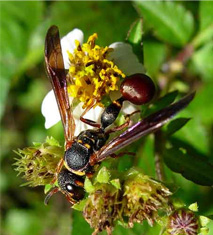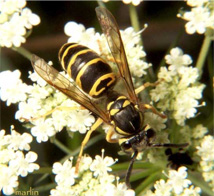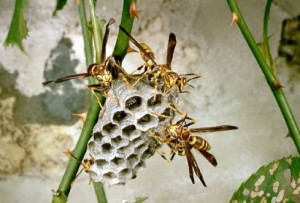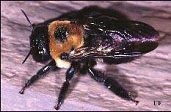 Mason Wasp of Florida
Mason Wasp of Florida
The genus Zethus is in the subfamily Eumeninae, which contains the mason and potter wasps. However, many Zethus species typically make their nests in twigs and branches (Porter 1978) using old insect burrows, although ground nesting is also common.
Members of the genus Zethus are widespread throughout the New World tropics. According to Bohart and Stange (1965) there are 189 recognized species in the Western Hemisphere, with the greatest number in the Brazilian region of South America. However, Porter (1978) lists only 187 in the same area. Arnett (2000) and Porter (1978) list seven species in America north of Mexico, two of which occur in Florida.
Z. spinipes Say has two subspecies found in the eastern United States, and Z. slossonae Fox is known from southern Florida. Zethus are easily mistaken for potter wasps (Eumenes) commonly found around the home. Unlike Eumenes spp. which build nests of mud, Zethus use either abandoned burrows of other insects or build nests from vegetable matter and resin.
 Yellow Jackets and Hornets
Yellow Jackets and Hornets
Only two of the 16 Nearctic species of Vespula are known from Florida (Miller 1961). These are the two yellowjackets: eastern yellowjacket, V. maculifrons (Buysson), and the southern yellowjacket, V. squamosa (Drury). One species of Dolichovespula is also present: the baldfaced hornet, D. maculata (Linnaeus). The baldfaced hornet is actually a yellowjacket. It receives its common name of baldfaced from its largely black color but mostly white face, and that of hornet because of its large size and aerial nest. In general, the term “hornet” is used for species which nest above ground and the term “yellowjacket” for those which make subterranean nests. All species are social, living in colonies of hundreds to thousands of individuals.
 Paper Wasp
Paper Wasp
Paper Wasp (AKA “Mahogany Wasp”) is the common name for medium- to large-sized wasps that construct nests made of a papery material. The nests consist of a single upside-down layer of brood cells (compartments for the young). There are 22 species of paper wasps in North America and approximately 700 species world-wide. Most are found in the tropics of the western hemisphere.
Most paper wasps measure about 2 cm (0.75 in) long and are black, brown, or reddish in color with yellow markings. Paper wasps will defend their nest if attacked. Adults forage for nectar, their source of energy, and for caterpillars to feed the larvae (young). They are natural enemies of many garden insect pests. A widespread North American species is the golden paper wasp.
The nests of most species are suspended from a single, central stalk and have the shape of an upside-down umbrella. Some tropical species make nests that hang in a vertical sheet of cells. Plant and wood fibers are collected by the wasps, mixed with saliva, and chewed into a papier-mêch?-like material that is formed into the thin cells of the nest. The nests are constructed in protected places, such as under the eaves of buildings or in dense vegetation. Normally a colony of several to several dozen paper wasps inhabit the nest.
The colony is founded in early spring, soon after the queens (mated females) emerge from hibernation. As the colony matures, males and the next year’s queens are produced. These queens mate with males and are the only members of the colony to survive through winter. In late summer or fall, the founding queen, workers (unmated females), and males all die. The newly mated queens hibernate, typically in piles of wood, in vegetation, or in holes. The following spring they emerge and begin the cycle anew. A similar life cycle is found in bumble bees.
In most temperate species of paper wasps, colonies are founded by one female who dominates the colony and lays most of the eggs. This female constructs the nest, lays eggs, forages, and raises the first generation of offspring. She then stops foraging, becomes the queen, and rules by dominating her offspring of workers. This is a classic dominance hierarchy with the queen maintaining control through aggressive interactions. Each individual in line maintains dominance over all others below her through confrontation and aggressive interactions. If the queen dies or is otherwise lost, the most aggressive worker takes over. This worker begins laying eggs and continues to dominate all below her. Since the workers have not mated, they can only lay unfertilized eggs, which develop into males, a typical trait in wasps.
Some queens that are unsuccessful at establishing their own nest may join another queen, submitting to her dominance and becoming a worker. Studies have shown that such individuals, called joiners, are most often sisters of the queen. Since this individual mated the previous fall, her eggs can develop into workers and she could become the next queen if the founding queen is lost. Occasionally a joiner dominates the founding queen and takes over the nest, a behavior known as usurpation. In such rare cases, the usurper becomes the queen and the previous queen becomes a worker.
Scientific classification: Paper wasps are in the genus Polistes in the family Vespidae, which also includes potter wasps, yellow jackets, and hornets. The golden paper wasp is Polistes fuscatus.
 Carpenter Bee
Carpenter Bee
Economic Importance
Chandler (1958) lists four types of damage done by carpenter bees: weakening of structural timbers, gallery excavation in wooden water tanks (especially in arid western areas), defecation streaking on houses or painted structures, and human annoyance. The last point is included since carpenter bee females may sting (rarely), and male bees may hover or dart at humans who venture into the nesting area. In general, carpenter bees are not much of a problem.
Carpenter bees rarely attack painted or varnished wood. While natural wood may be attractive, if there is a problem with carpenter bees, you may have to apply a finish to the wood. These bees often cause problems on structures by boring into the surface of the wood that is the back face of the trim under the eaves, as this surface is usually not painted. A buzzing or drilling sound is heard when the bee is boring into the wood. If the hole is not visible, often the case when the bee is boring into the backside of trim, look for sawdust on the ground under the hole.
The photos and information above were provided by the University of Florida ![]()
